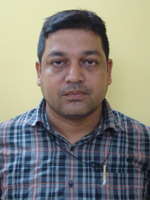Departmental profile
The demand for fish is increasing in India in both domestic and export market which necessitates enhancing the supply rate regularly. On the other side, the aquatic resources facing challenges due to global warming and consequent biodiversity depletion which impedes the fish production and, thus, resulting in a mismatch between demand and supply. Management of fisheries resource in a sustainable manner with a holistic approach is a panacea to such issue. The state of West Bengal is one of the leading states in fish production but also unique in harbouring all type of resources (marine, brackish water, fresh water and cold water) and 696 species of piscine diversity. Such rich resource potential provides ample scope for exploitation to place it in commanding heights of fishery economy in country. Skilled manpower is needed to manage the vast and varied fish resource of the country in general and the state in particular. Management of different fishery resources with available technology can augment fish production and also strengthen livelihood security of poor fisher communities. Department of Fisheries Resource Management, Faculty of Fishery Sciences, WBUAFS, is betrothed in producing such skilled manpower.
The Department of Fisheries Resource Management has been offering courses at undergraduate, postgraduate and doctorate levels. The Department is offering M.F.Sc. and Ph.D. programmes in Fisheries Resource Management. The Department is well equipped with UG laboratory, PG laboratory and seminar room. The curriculum is being revised time to time as per the need of time. The undergraduate and postgraduate courses were updated during 2016-17 and 2009-10 as per the Fifth Deans’ Committee’s recommendation (ICAR) and Broad Subject Matter Area Committee (ICAR), respectively. Pedagogy is being performed with adoption of internet facilities to update knowledge of students. The post graduate students carry out research work emerging and need based areas of fisheries resource management for their research works and such results are being published in different reputed journals. Seminars are held regularly in emerging topics to enhance postgraduate students’ knowledge. So far sixty students have been completed their M.F.Sc. from this Department. The students regularly visit fish landing centres of West Bengal, ICAR fisheries institutes and, other institutes and organizations to acquaint with current scenario of fish and fisheries. Teachers regularly attend different conferences, symposia, workshops, seminars etc. to enrich their knowledge. They also extend their expertise in Fishery Science to other Universities and Institutes by associating with their postgraduate examinations as examiners and in research activities.
Faculty Member
Faculty: Faculty of Fishery Sciences
Head of the Department. : Prof. T.S. NageshDR. SUDHIR KUMAR DAS
Qualification : M.F.Sc., Ph. D. & D.D.E
Designation : Professor
Phone : +91 9433565224
Mail ID: dassudhirkumar1@gmail.comPUBLICATIONS
National: 75
International: 03
Popular Articles: 93
Manual: 02
Books/ Books Chapter: 32STUDENT GUIDANCE
Master Degree: 23
Post Doctoral: 0View Detail Profile DR. SAMARENDRA BEHERA
Qualification : M.F.Sc. & Ph. D.
Designation : Professor
Phone: +91 9433164210
Mail ID: samarendrab234@gmail.comPUBLICATIONS
National: 62
International: 01
Popular Articles: 04
Manual: 02
Books/ Books Chapter: 01STUDENT GUIDANCE
Master Degree: 18
Post Doctoral: 0View Detail Profile DR. NAGESH TALAGUNDA SRINIVASAN
Qualification : M.F.Sc. & Ph. D.
Designation : Professor
Phone: +91 9330961430
Mail ID: tsnagesh1@rediffmail.com, tsnagesh2@gmail.comPUBLICATIONS
National: 63
International: 18
Popular Articles: 06
Manual: 02
Books/ Books Chapter: 02STUDENT GUIDANCE
Master Degree: 21
Post Doctoral: 02View Detail Profile DR. GOLAM ZIAUDDIN
Qualification : M.F.Sc. & Ph. D.
Designation : Assistant Professor
Phone: 9474484157
Mail ID: golamziauddin@gmail.comPUBLICATIONS
National: –
International: –
Popular Articles: –
Manual: –
Books/ Books Chapter: –STUDENT GUIDANCE
Master Degree: –
Post Doctoral: –View Detail Profile Course
Course offered:Undergraduate Programme Course No. Course Title Credit Hours FRM–111 Taxonomy of Finfish 1+2 FRM–122 Taxonomy of Shellfish 1+1 FRM–123 Anatomy and Biology of Finfish 2+1 FRM–124 Anatomy and Biology of Shellfish 1+1 FRM–215 Physiology of Finfish and Shellfish 2+1 FRM–216 Inland Fisheries 2+1 FRM–317 Aquatic Mammals, Reptiles and Amphibians 1+0 FRM–318 Marine Fisheries 2+1 FRM–329 Fish Population Dynamics and Stock Assessment 2+1 Post-graduate Programme Course No. Course Title Credit Hours FRM–501 Inland Fisheries Resources 2+1 FRM–502 Marine Fisheries Resource Management 2+1 FRM–503 Marine Ecosystems, Biodiversity and Conservation 2+1 FRM–504 Tropical Fish Stock Assessment 2+1 FRM–505 Fisheries Regulations 2+1 FRM–506 Remote Sensing and GIS For Fisheries Management 1+1 FRM–507 Integrated Coastal Zone Management 2+1 FRM–508 Aquatic Floral Resources 2+1 FRM–509 Feeding and Reproductive Biology of Finfish and Shellfish 2+1 FRM–510 Developmental Biology of Finfish and Shellfish 2+1 FRM–511 Fishing and Allied Technologies 2+1 FRM–512 Modern Techniques in Ichthyotaxonomy 2+1 FRM–591 Masters’ Seminar 1+0 FRM–591 Masters’ Research 0+20 Ph D Programme Course No. Course Title Credit Hours FRM–601 Assessment of Aquatic Biodiversity 2+1 FRM–602 Applications of Fisheries Models in Stock Assessment 2+1 FRM–603 Conservation and Management of Exploited Fisheries Resources 2+1 FRM–604 Coral Reef Management 2+1 FRM–605 Data Collection and Estimation of Exploited Fisheries Resources 0+2 FRM–606 Fisheries Environmental Assessment 2+1 FRM–607 Issues In Capture Fisheries 2+1 FRM–691 Doctoral Seminar – I 1+0 FRM–692 Doctoral Seminar – II 1+0 FPT 699 Doctoral Research 0+45 Project Completed / ongoing
Completed Sl.No. Title Name of PI Period Funding Agency Budget (Rs. in lakhs) 1 Determination of threatened status and cytological characterization of fish species of Nadia and Howrah districts, West Bengal. Prof. Nagesh Talagunda Srinivasan 2001-2004 DST, Govt. of West Bengal 3.890 2 “Breeding and larval rearing of a threatened fish of Ababas testudineus” Prof. Samarendra Behera 2004-2007 ICAR, New Delhi 7.051 3 “improper Fish Breeding Practices and its Impact on aquatic bio- diversity and its role on native gene pool” Prof. Samarendra Behera 2013-2014 DST, Govt. of West Bengal 2.004 Research Findings
Project Name: Determination of threatened status and cytological characterization of fish species of Nadia and Howrah districts, West Bengal.- The categorization of threatened fish species was done by following the guidelines of IUCN and NBFGR and by assessing the present availability (%) with respect to base year 1960.
- It was found that, 48 fish species belonging to 9 orders have become threatened in the regions studied while another two species are approaching threatened status. The status of four species is unknown.
- Threatened fishes included 17 endangered, 14 vulnerable, 10 near vulnerable, 5 upper risk and 2 lower risk. The present availability (%) of EN, V, NV, UR, LR and AT is 9%, 21%, 36%, 51%, 65% and 78% with respect to base year 1960. Among the groups of fishes the most affected ones are catfishes (19) followed by carps (9), eels and eel like fishes (6), percids (6), snake heads (3), featherbacks (2), clupeids (2) and belonid (1).
- The karyotypic data on 15 threatened fishes were recorded in detail. The results achieved using spleen cells were significant and yielded numerous and good quality chromosome spreads. The diploid (2n) chromosome number varied from 32 to 54 in the fish species studied.
- Two mass awareness programmes on “FISH CONSERVATION” at Krishnanagar (Nadia) on 25.08.2004 and at Garchmukh (Howrah) on 14.10.2004 were conducted involving fishermen of Nadia and Howrah districts.
Project Name: “Breeding and larval rearing of a threatened fish of Ababas testudineus”
- For captive breeding of Anabas testudineus induced breeding techniques was adopted and for this a synthetic hormone Ova-FH was used.
- Three different breeding sets (female: male=1: 1or2or3) in three different water mediums (rain water, pond water, 50% mixing of both).
- In the prevailing condition (mix water, Ova-FH and sex ratio of 1:2) the breeding success was found maximum. The fecundity 0.35 lakhs, fertilization of 85% and hatching of 86%. The survival rate was 83.33% after yolk-sac absorption.
- Most important factor that determines the success of larval rearing of Anabas is removal of shoot fries periodically.
Project Name: “improper Fish Breeding Practices and its Impact on aquatic bio- diversity and its role on native gene pool”
- Conversion of IMC hatchery into exotic fish hatcheries in West Bengal is a major concern for the traditional fish farmers of the state and India because India is carp country.
- Cause of conversion of IMC hatcheries :
- The maintenance cost required for IMC’s hatcheries is much more than that of profit turnover.
- The exotic species like Pangasius, Piaractus are voracious eaters and prolific breeders who can breed 2-3 times in a reproductive cycle. They are very much stress resistant and can withstand transportation sock. Moreover there is a market demand for these fishes due to their palatable and tasty flesh.




